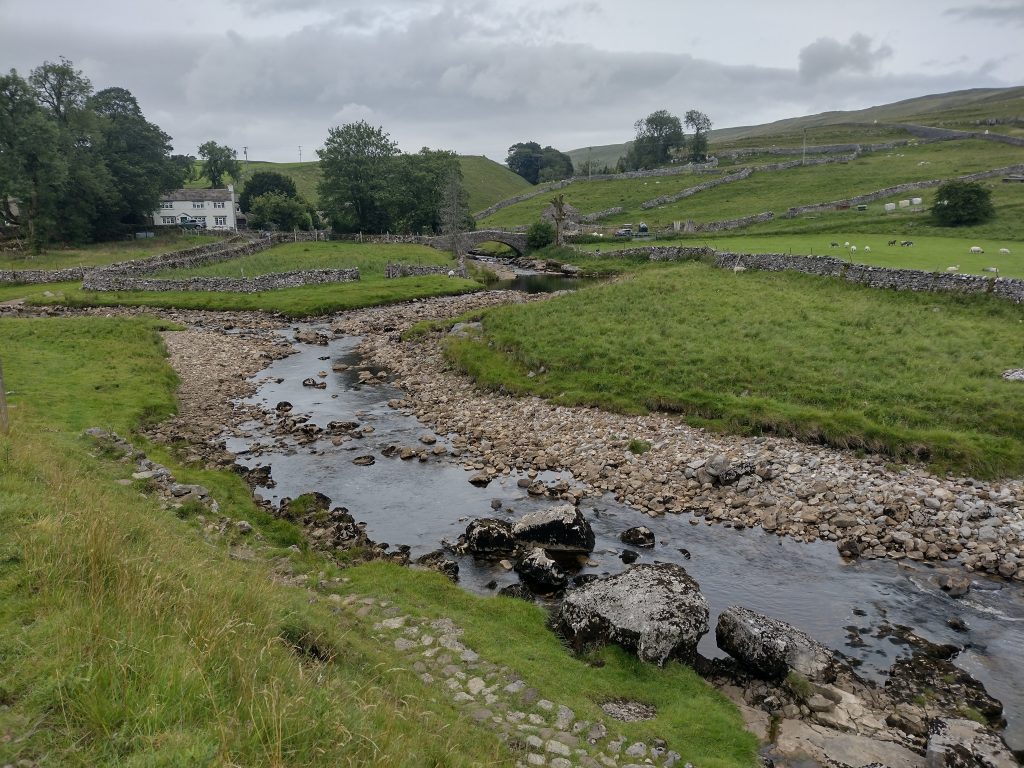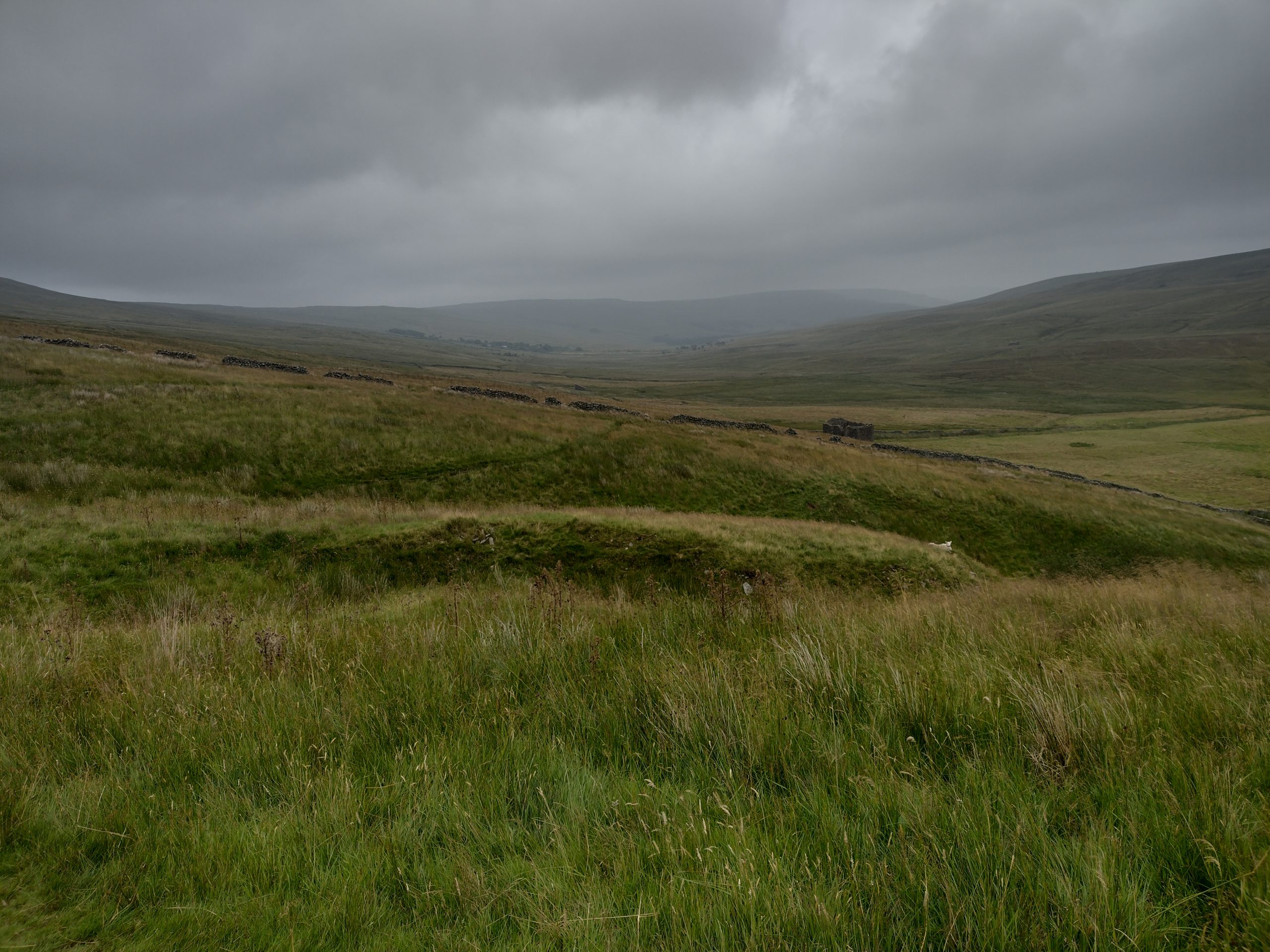This time, I had to plan carefully. I wanted it to be perfect: clear skies, preferably with some sunshine – to make everything look prettier – but not too hot for sweating up the hills, and requiring twice as much water to carry. My bag needed to be a lot lighter, too. Then there was the public transport situation to consider: The train between Leeds and Ribblehead was easy. The other end was a bit trickier: the last bus from Buckden to Skipton, from where I could then pick up a train (under normal circumstances) was at twenty past four. Unless I left Shadwell, my temporary home, at an ungodly hour, and began walking two hours later at eight in the morning, I couldn’t guarantee I would make it. Especially with my track record of losing my way, and then I’d be stranded. I could, of course, do it the other way around – the easy way – but I wanted to finish as I’d begun, or rather, pick up where I left off.
I had the idea that Helen could drive to meet me in Hubberholme, Yockenthwaite or Buckden, and we could spend the night in one of the cosy Yorkshire Dales hotels, my treat. But there were many evenings she wasn’t free, and they all seemed to coincide with the best weather, according to the ten different sites I researched obsessively. It was a conundrum.
It was now a whole year since I walked the Dales Way, and I had spent most of it regretting that I missed out on Day 4, the Ribblehead to Hubberholme section, due to the poor weather and zero visibility. I had to do it this summer. Nobody knows what’s around the corner, of course, but the way my life has been lately I can’t be sure even which country I’ll be in this time next year. Not that I’m complaining; I wouldn’t have it any other way. But I needed to get this thing done while I had the chance.
I was also really looking forward to being out on the hill again, and to completing this particular section, which included the highest point on the trail. I remembered that last July I often felt rushed, and wished I had longer to linger by a stream or find the best angle for a photograph. The solution I found was to do it over two days, with an overnight stay bang in the middle. An Aha! moment brought me to a ‘walkers’ flat’ within the very lovely Swarthghyll Farm.
I left the house at around seven thirty and was walking by ten. It took a while before I was convinced I was going the right way. My instinct, last year, was to turn right upon leaving the Station Inn, but Helen had insisted, and backed it up with map, guidebook and photographic evidence, that I should have turned left out of the door – or right, out of the railway station, as I was now doing. This time, I had photographed the appropriate parts of the ordnance survey map and the pages in the guidebook (not the one I unceremoniously dumped as not being worth its weight) as well as meticulously written out the instructions for the route, back to front, on paper, which I stuffed into my back pocket. Yet it still felt wrong, to me, and I had to keep checking.
In both directions, parked cars lined the sides of the road. For a very brief moment I imagined they were all heading in the same direction as I, before I realised they were, of course, climbing Whernside, or going for a mooch around the viaduct. My route took me along this rather fast road for a mile and a half before branching onto a wide, stony track leading up the hillside in an ugly, white scar. You would imagine such paths would at least be well-signposted, but I had a quandary at the top of the hill where the wooden sign mentioned only The Pennine Way, and not its lesser cousin, The Dales Way. I knew the two trails converged for part of today, and on whipping out my instructions (now damp from where I sat on a clump of reeds), my new, improved wayfinding skills were confirmed.
The somewhat tedious path culminated in an equally ugly, but welcome and significant cairn: the highest point on the Dales Way. It seemed to appear quite suddenly, and without fanfare; I would venture to say it didn’t even seem particularly high up, but then I was not within the context of a six-day trudge. At the cairn, the path left the Cam High Road – a Roman road, hence its straight featurelessness – and gently descended onto soggy moorland. My eyes were glad of the change, if my feet rather less so, but I was relieved it had been a dry summer, and I didn’t disappear into any bogs.
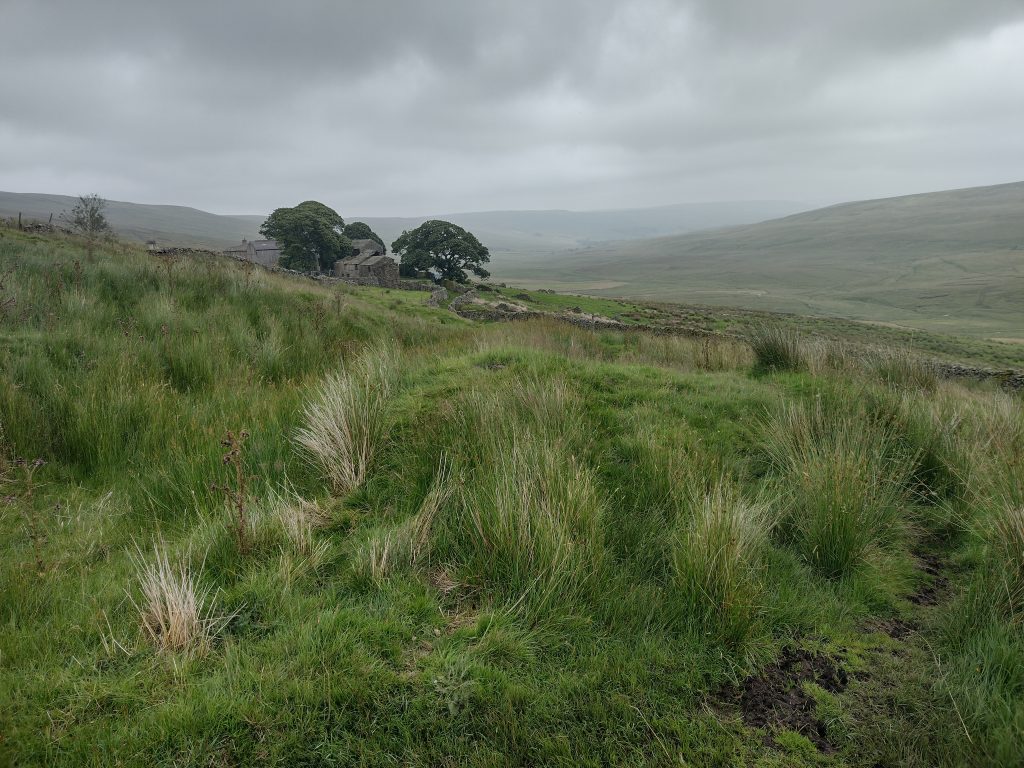
Soon some farm buildings came into sight, looking very Wuthering Heights across the bleak moor. The jumble of buildings making up Cam Houses was home to a collection of confusing gates and stiles, and maintained a ramshackle and unloved air, complete with the sound of gunshots down the slope. I chose to assume there was some practice shooting going on, because it couldn’t be time for the grouse, yet, and there were too many rounds fired for it to be a murder, unless the gunman was very clumsy. The cracks and their echoes reverberated around the valley as a vaguely menacing intrusion; I hoped the perpetrators were enjoying themselves.
The guidebook instructions – yes, I read them – told me to keep a stone wall on my right, so after going through an iron farm gate, that’s what I did. I followed the edge of a field from which the reeds had been cut and lain helpfully across the track, making it pleasantly soft and dry underfoot. Either someone was being extremely thoughtful, or there was such a heavy footfall on the path it was becoming boggy and degraded. Some youthful figures walked past in the opposite direction, on the other side of the wall; the shooting party returning to Cam Houses for coffee, I imagined. A few minutes later, a couple of blokes approached in the same manner; this time walkers, judging by their gear. One was a few paces in front of the other, and they were talking loudly to be heard in the wind. The one at the rear shouted a warm hello over the wall, then when I’d passed them, I heard him say to his companion,
‘No, it’s not us who’s wrong. It definitely said the Dales Way.’
Had I missed a gap in the wall, or mistakenly copied down an instruction for ‘left’ as ‘right’? Oh well, I was heading in the right direction; presumably there would be a gate at the top where I could rejoin the correct path, just a few metres away. Of course, there wasn’t. Instead, the field I had somehow chosen to walk in descended steeply to a slippery burn, with a barbed wire fence the other side atop a drystone wall. As usual, I could see no other exit. I could either retrace my steps back to Cam Houses and find the path on the correct side of the wall, or take matters into my own hands and turn the day’s walk into an expedition, in my unique fashion. I clambered over gingerly enough to not dislodge the very loose rocks, but my t-shirt caught on the barbed wire. The hole it now sports is a lasting testament to my poor attention at junctions, or feeble comprehension of carefully-worded instructions; I may never know which.
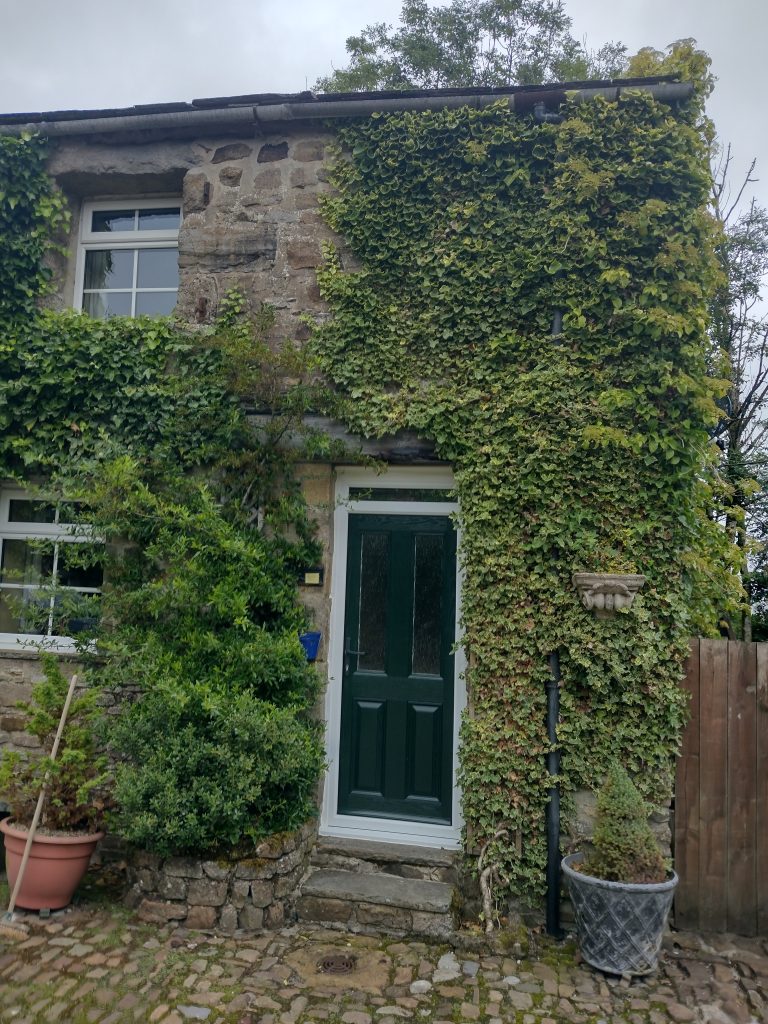
This part of the Dales has a gloriously remote feel, and it was easy to imagine the only way to access these hill farms was on foot, so I was mildly surprised when, after passing through some new plantations of native, broadleaf trees, I arrived at Swarthghyll farm to find a collection of ordinary cars, alongside the expected tractors and pick-ups. I was even more taken aback to read, in the visitor information, that there were recommended restaurants for one’s evening meal in places such as Hawes. They might just as well have suggested the moon, for the likelihood of my going there, instant noodles at the ready or not. I supposed some people came to stay for a few days with their own transport, simply enjoying the peace and quiet of this lovely spot. To be fair, the ‘road’ was more of a bridle path, complete with grass growing down the middle, although I wouldn’t know that until the following day. I clung to the fantasy of being surrounded by nothing but windswept peat bog.
My accommodation was at one end of a grand old stone farm building, covered with ivy and climbing hydrangea and set within an attractive, sheltered courtyard. I was told a red squirrel and a woodpecker regularly visited the bird feeder, though neither came to say hello while I was in residence. As I arrived in the early afternoon there was time for a bagless, bootless stroll and to sun myself on the step of my flat, sheltered from the cool breeze; we were, of course, still high on a hill. While this half of the walk had been easy, I was glad I chose to do it the civilised way; I would, indeed, have been rushing for that bus, and enjoying the quiet courtyard with the sun on my face, watching the comings and goings of a working farm, would be a small, simple highlight of the walk.
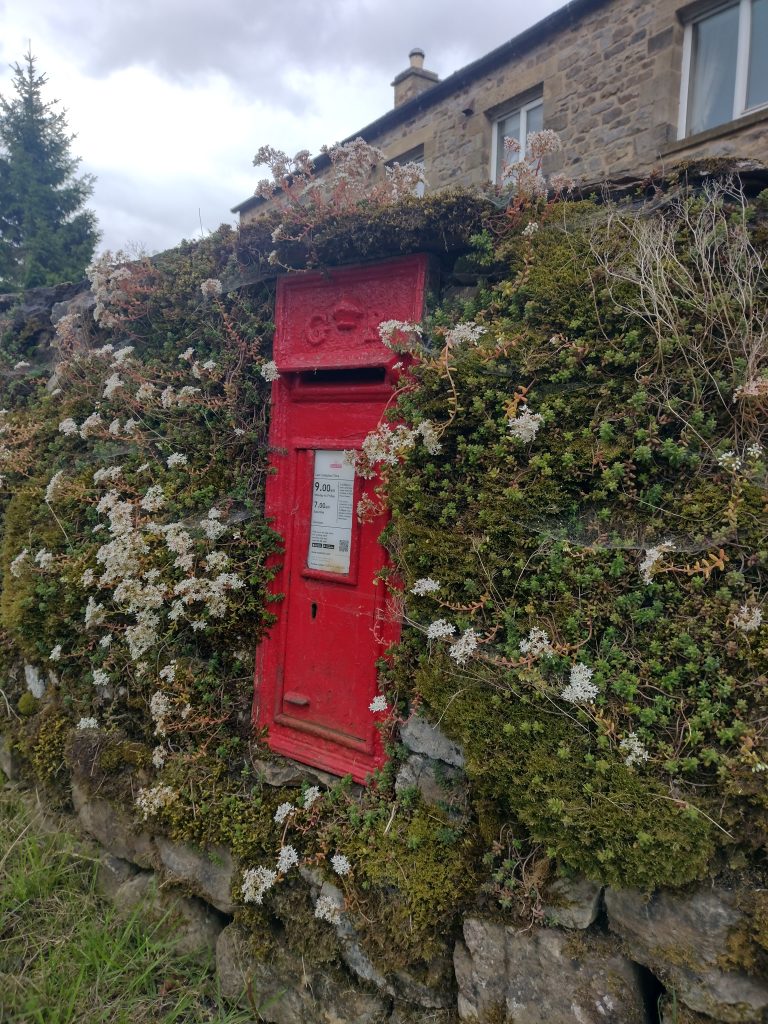
Almost reluctant to leave the place after a leisurely breakfast, I set off down the track on the final leg of the journey which had somehow taken a year to complete. At the end of the farm track, the way followed the minor road through Oughtershaw, another village so quiet you’d be forgiven for thinking it was uninhabited, and all the way down to Beckermonds. There is a surprising amount of road-walking along the Dales Way, even without the extra miles I was prone to doing by accident, which I was a little disappointed by. However, the roads were mostly very quiet and rural, so apart from the hard surface underfoot, could almost be thought of as footpaths. This morning, I passed one group of cyclists and was buzzed by a number of motorbike convoys, but encountered no fellow walkers until the approach to Yockenthwaite, where wide, flat stones edged the lazy river in an idyllic natural picnic area. There were deep pools where I was sorely tempted to swim, but the thought of staying wet for the rest of the day soon killed the appeal.

From here, I knew my way, and apart from finding myself on top of a hill when I should have been strolling along the riverbank (don’t ask; at least the view was worth it), the journey was simple; the gorgeous, flower-lined path across stiles and through meadows between Yockenthwaite and Hubberholme, a familiar delight. Arriving early for the two-thirty bus to Grassington, I had time for a paddle under the bridge and a bottle of cider outside the Buck Inn before it began to cloud over.
Unfortunately, it all went south from there. The wonderful, if infrequent, Dales Bus got me to Skipton in perfect timing for the four o’clock train to Leeds. Even with another bus to catch at the other end, I’d be back before six. It didn’t quite work out like that, however; there was a fault affecting the signals all over the county, they said after a forty-minute delay, and I had to get a bus to Leeds, via Ilkley. Buses are even thinner on the ground than I remember from the past, and I eventually crawled in at half past nine in the evening, a whole eight hours after arriving in Buckden.
Now, after finally completing the Dales Way, I was tempted to say: I’d have got there quicker if I’d walked.
